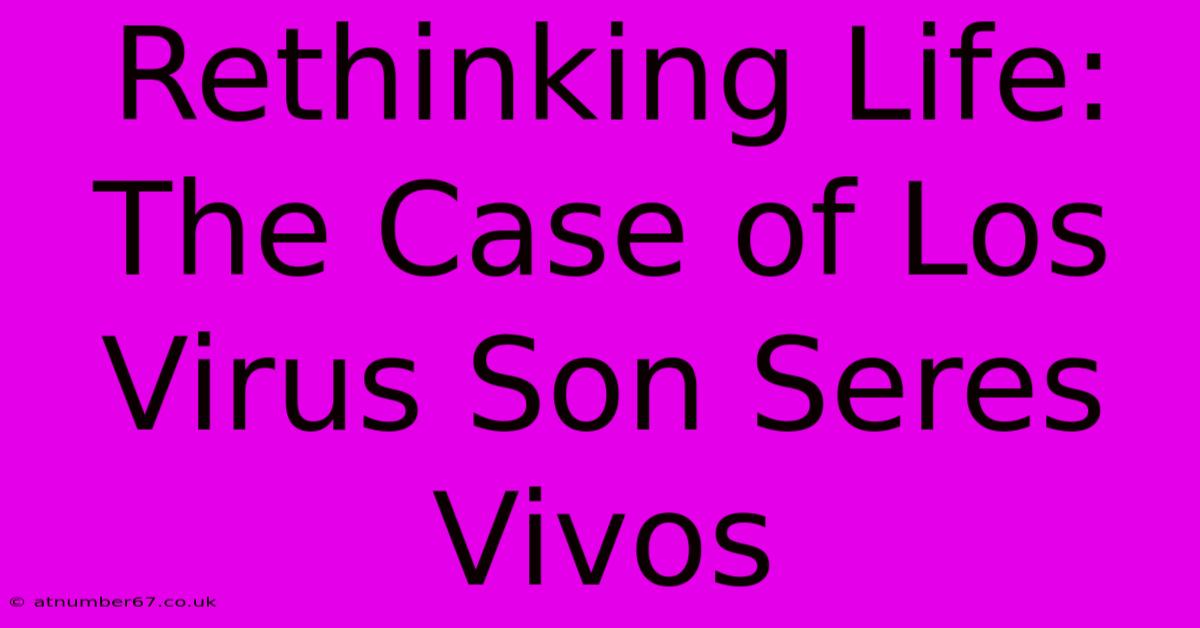Rethinking Life: The Case Of Los Virus Son Seres Vivos

Table of Contents
Rethinking Life: The Case of Los Virus Son Seres Vivos
The question of whether viruses are alive has been a long-standing debate in the scientific community. Traditionally, the definition of life has centered around characteristics like reproduction, metabolism, and response to stimuli. However, viruses, those microscopic entities that hijack cellular machinery to replicate, blur the lines of this traditional understanding. This article delves into the complexities of viral existence, exploring arguments for and against classifying los virus son seres vivos (viruses are living beings).
The Traditional View: Why Viruses Aren't Considered Alive
For decades, the prevailing scientific consensus leaned towards classifying viruses as non-living entities. Several key reasons underpin this perspective:
1. Lack of Cellular Structure:
Unlike cells, the fundamental units of life, viruses lack the complex internal organization required for independent metabolic processes. They are essentially genetic material (DNA or RNA) encased in a protein coat, lacking the organelles and cellular machinery necessary for energy production or nutrient processing.
2. Dependence on Host Cells:
Viruses are obligate intracellular parasites. This means they cannot replicate on their own; they require a host cell to provide the necessary resources and machinery for viral replication. This dependence fundamentally distinguishes them from independent living organisms.
3. Absence of Metabolism:
Viruses lack their own metabolic pathways. They do not produce their energy or synthesize their own building blocks. Instead, they rely entirely on the host cell's metabolic machinery to replicate.
4. Inert Outside a Host:
Outside a host cell, viruses exist in an inert state. They exhibit no metabolic activity, reproduction, or response to stimuli. They are essentially inactive particles awaiting an opportunity to infect a host.
The Evolving Perspective: Arguments for Considering Viruses Alive
While the traditional view remains influential, a growing body of research challenges the simple categorization of viruses as non-living. New perspectives argue that a rigid definition of life might be too narrow and that viruses exhibit some characteristics traditionally associated with life:
1. Evolution and Adaptation:
Viruses evolve and adapt to their hosts through mutation and natural selection. They exhibit genetic diversity and can develop resistance to antiviral treatments, demonstrating a capacity for evolutionary change crucial to the definition of life. Their rapid evolution underscores their ability to adapt to changing environments.
2. Information Storage and Transmission:
Viruses store and transmit genetic information, albeit in a different manner than cellular organisms. Their genetic material encodes the instructions necessary for replication and interaction with host cells, fulfilling a fundamental aspect of life's processes.
3. Reproduction (of sorts):
Although dependent on host cells, viruses replicate their genetic material and assemble new viral particles, a process that could be considered a form of reproduction, albeit a highly specialized one. They increase in number and spread within a host.
4. Interaction with the Environment:
While their interactions are limited by their parasitic nature, viruses do respond to environmental cues, such as the presence of suitable host cells. This could be considered a primitive form of response to stimuli.
Redefining Life? The Ongoing Debate
The question of whether los virus son seres vivos remains open for debate. The traditional definition of life may be too restrictive to encompass the unique characteristics of viruses. Perhaps, a broader definition is needed, one that accounts for the diverse ways in which biological entities can exist and interact with their environments. The ongoing research into virology and the ever-expanding understanding of life's diversity will likely continue to shape our understanding of the viral world and its place in the biological spectrum. The debate forces us to reconsider the very definition of life, moving beyond simple checkboxes and towards a more nuanced understanding of what constitutes existence.
Keywords:
Viruses, living beings, los virus son seres vivos, viral replication, obligate intracellular parasites, evolution, adaptation, metabolism, reproduction, host cells, genetic material, DNA, RNA, definition of life, virology, scientific debate.

Thank you for visiting our website wich cover about Rethinking Life: The Case Of Los Virus Son Seres Vivos. We hope the information provided has been useful to you. Feel free to contact us if you have any questions or need further assistance. See you next time and dont miss to bookmark.
Featured Posts
-
Mammoottys Son Breaking Barriers
Apr 07, 2025
-
Understanding Albanian Culture And The Age Of Consent
Apr 07, 2025
-
Mileys Mom Her Biggest Fears
Apr 07, 2025
-
Mahesh Kafle How His Age Has Shaped His Identity
Apr 07, 2025
-
Find The Exact Time In Nuevo Laredo
Apr 07, 2025
